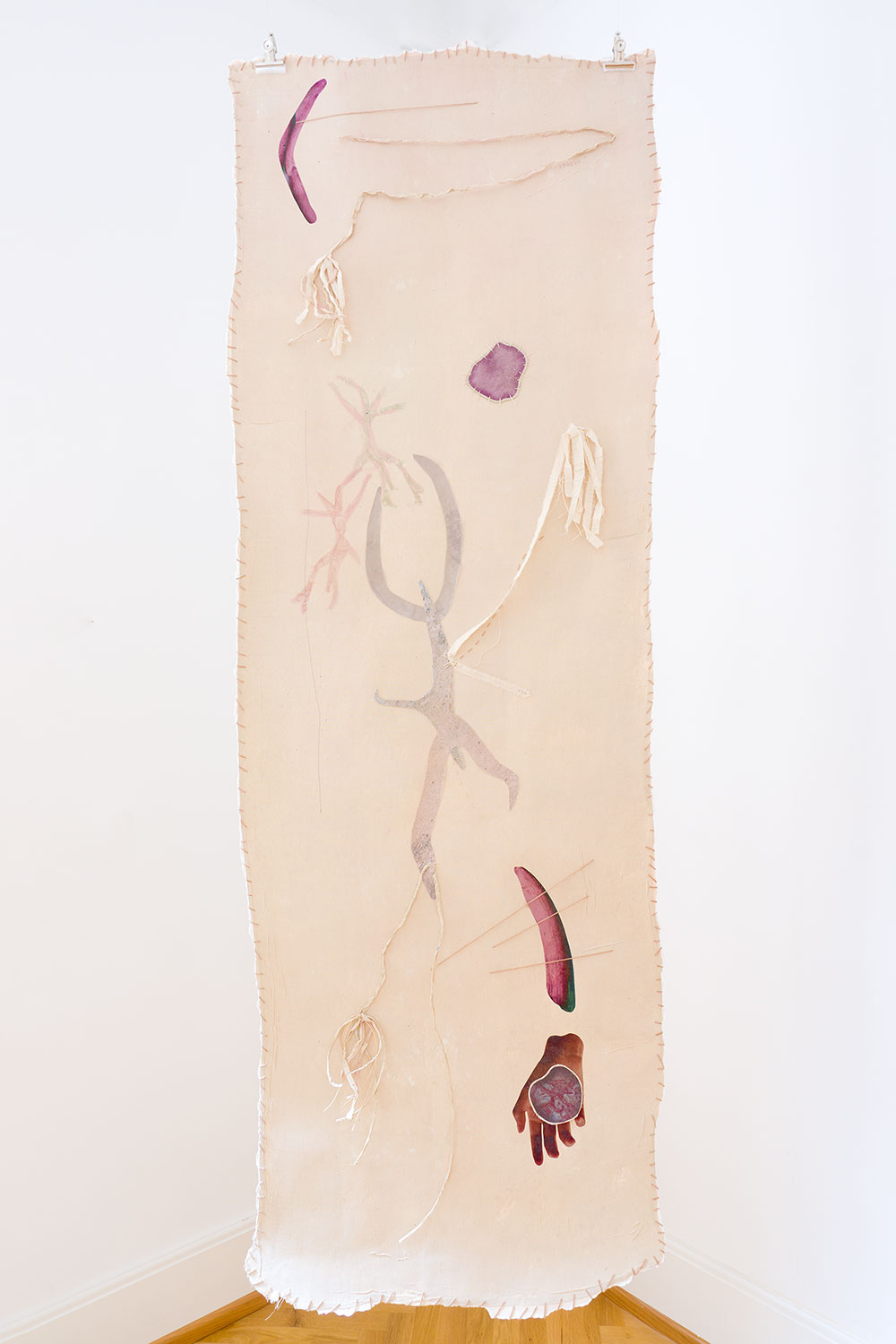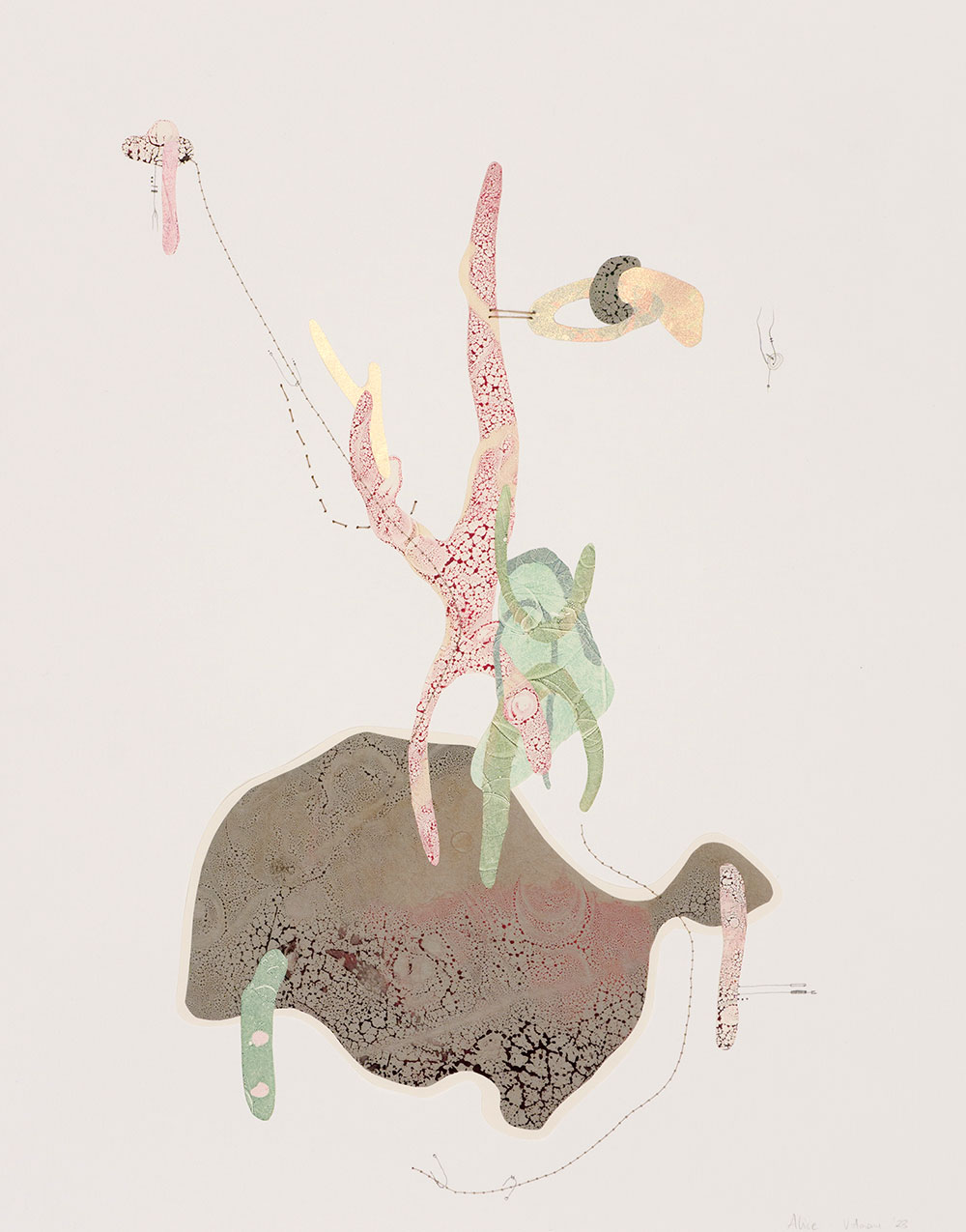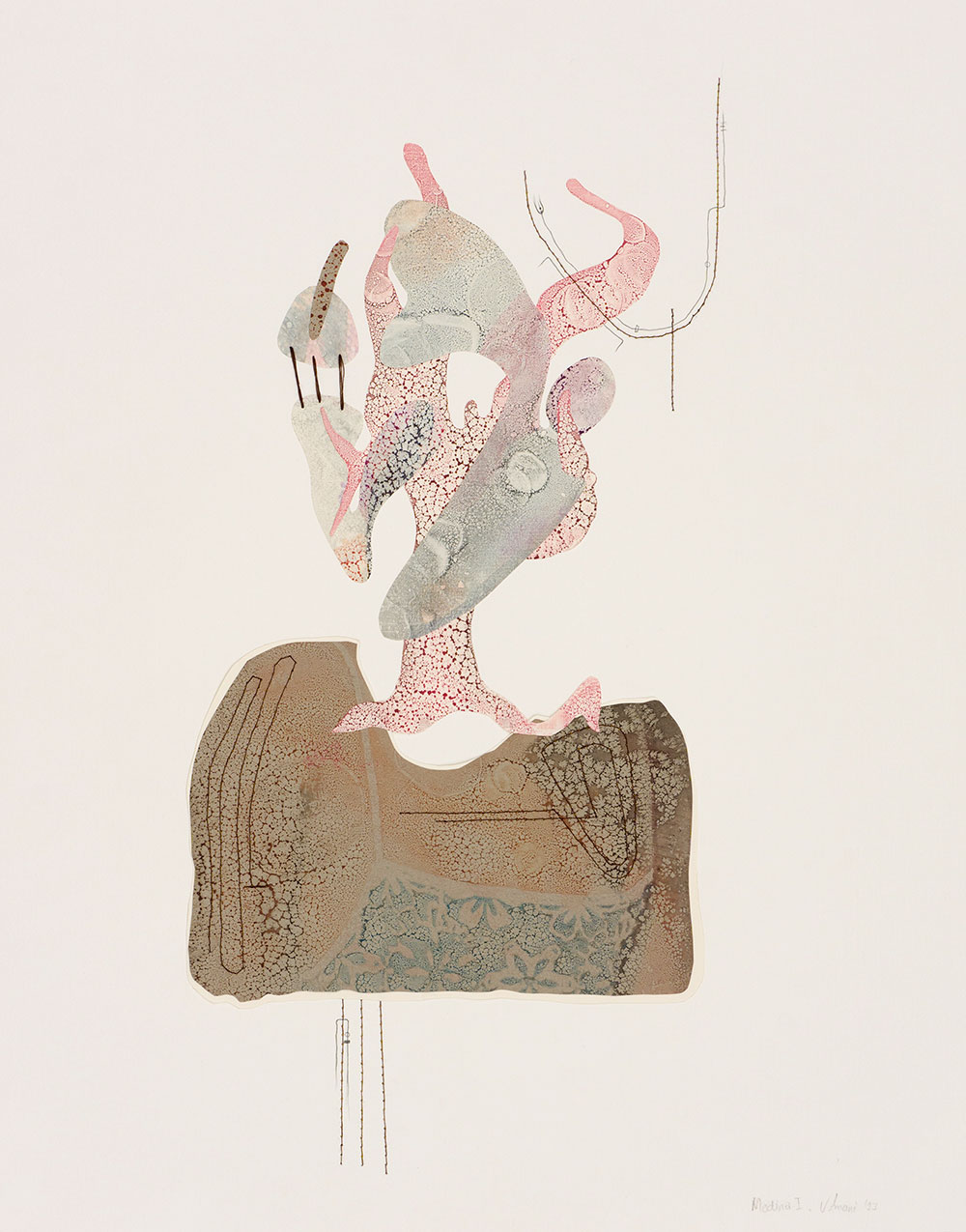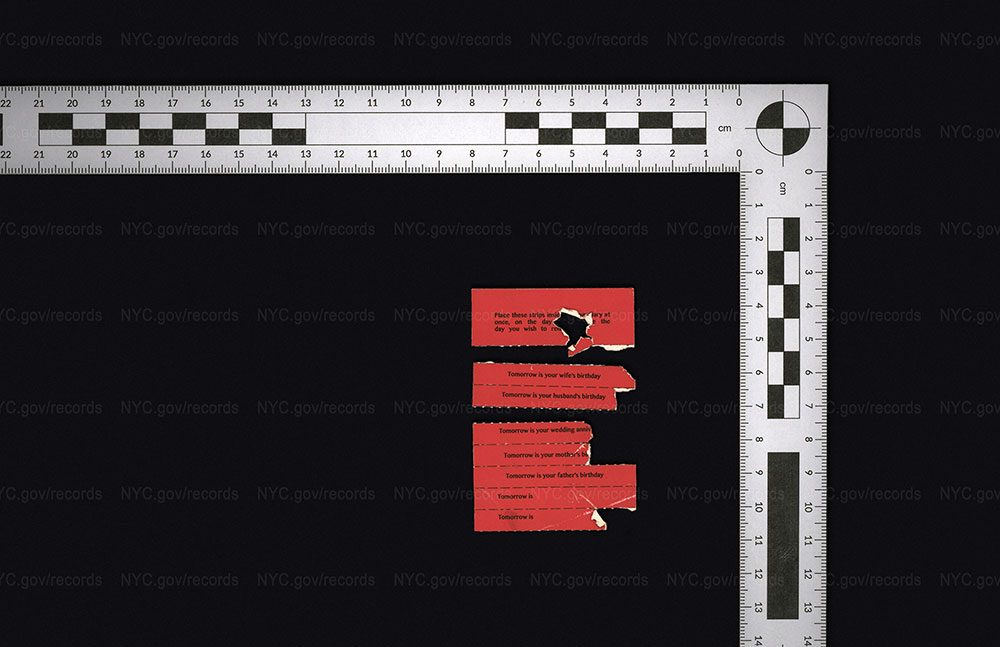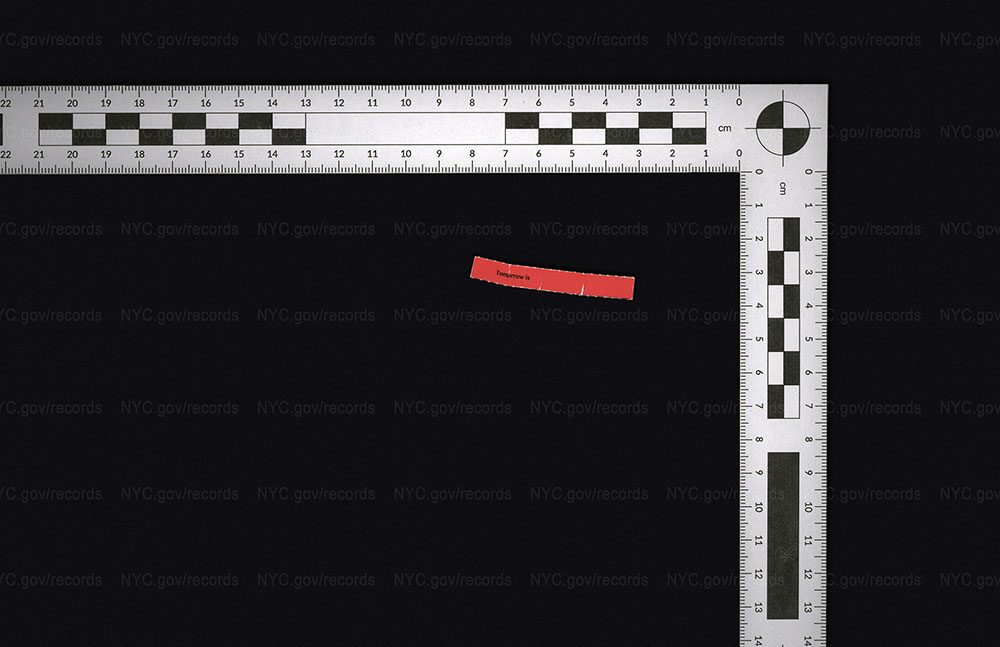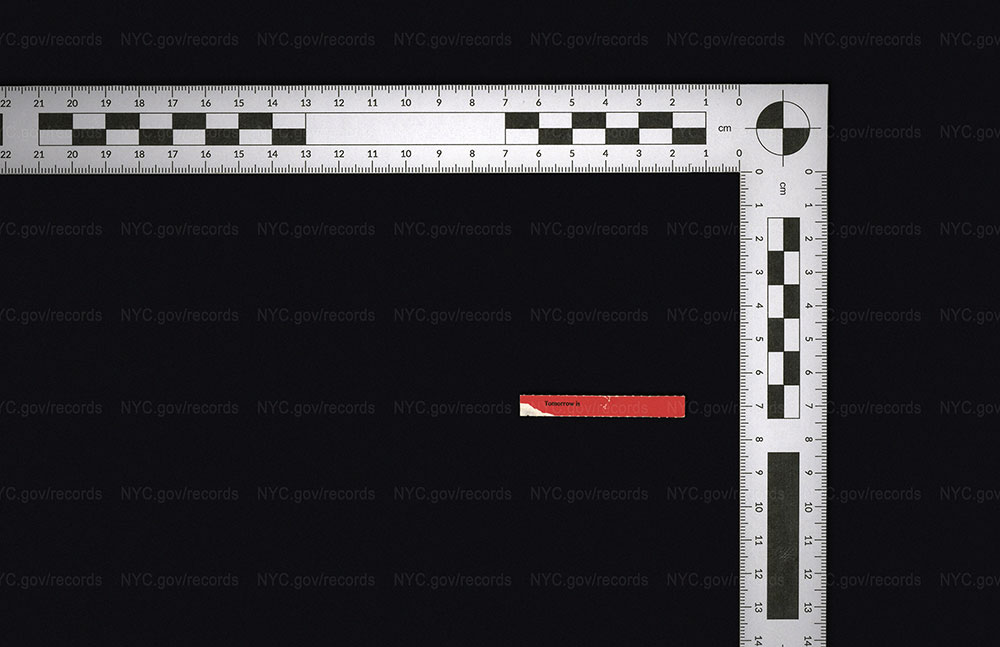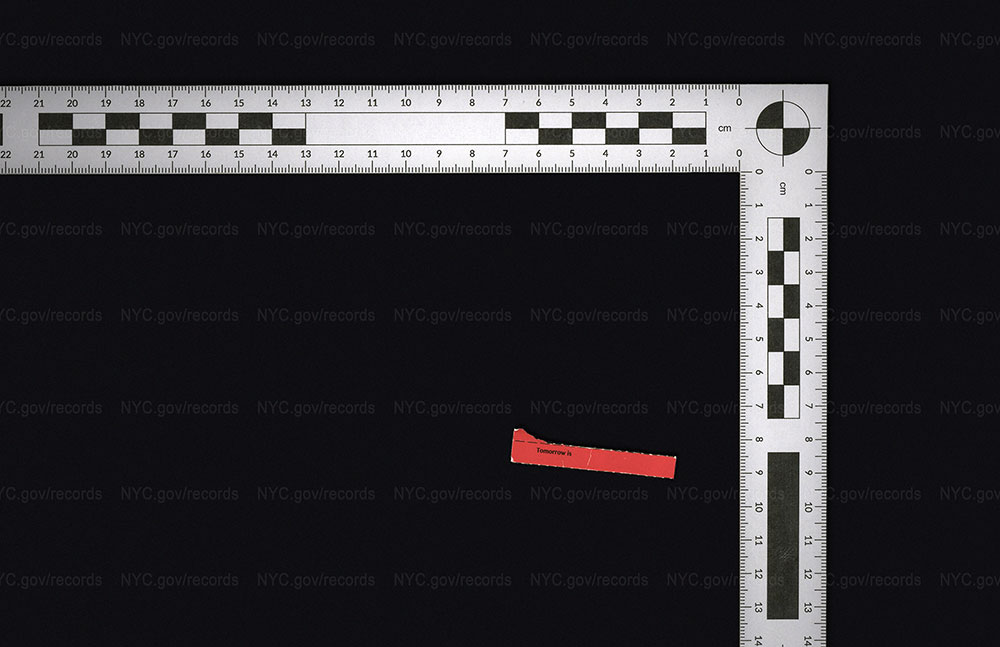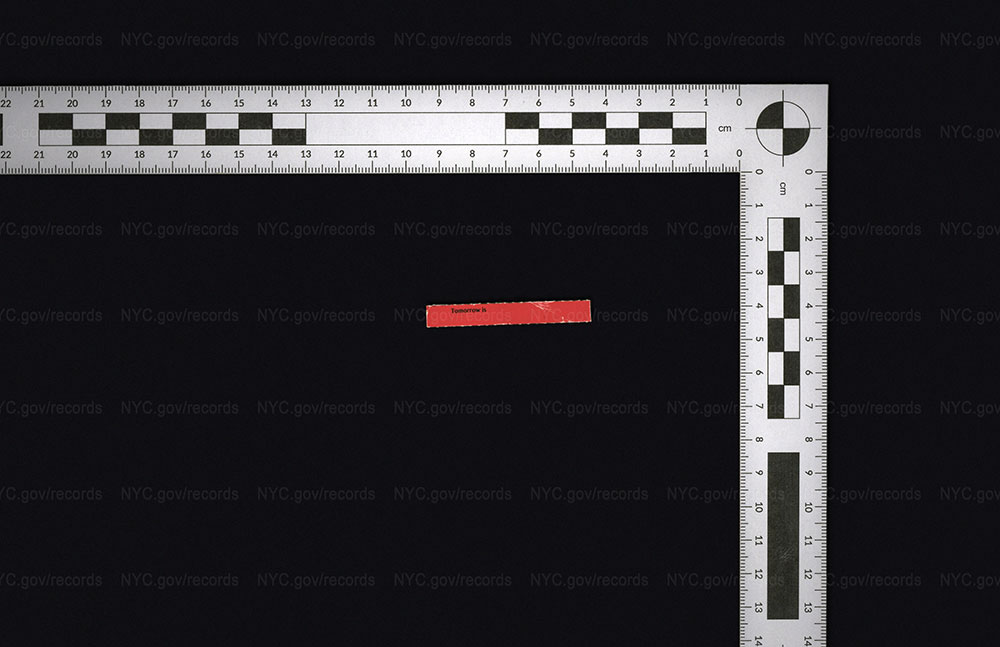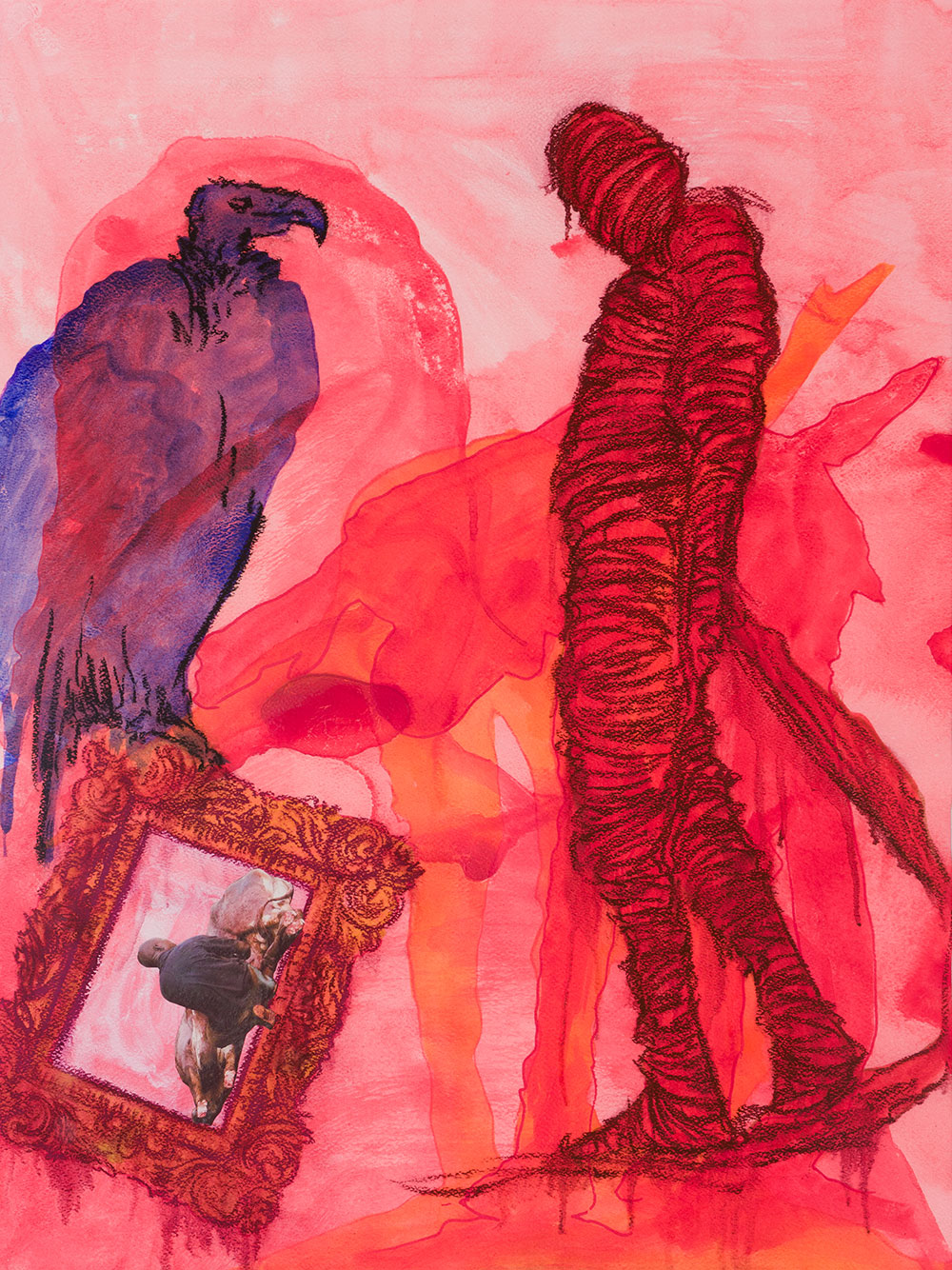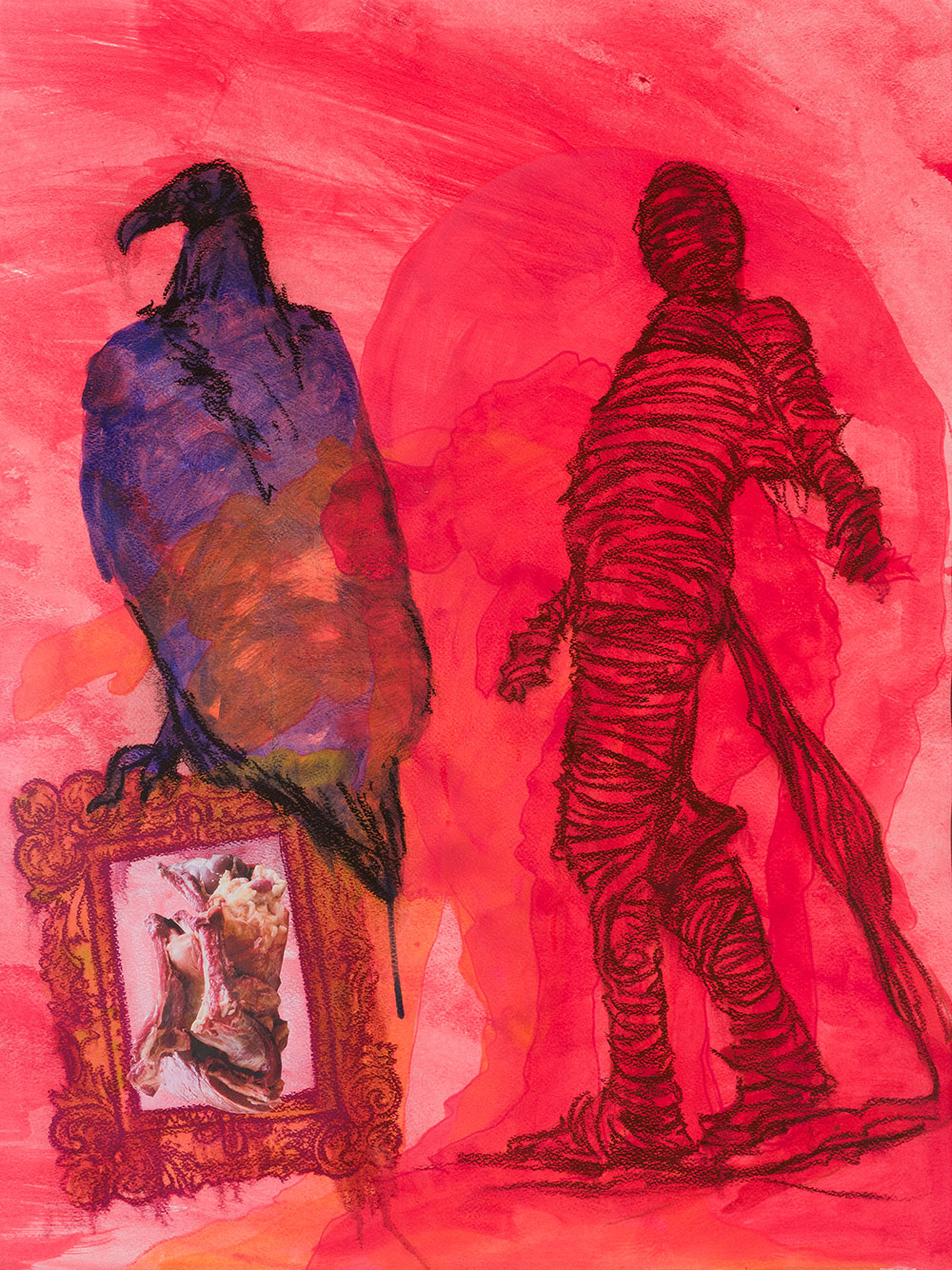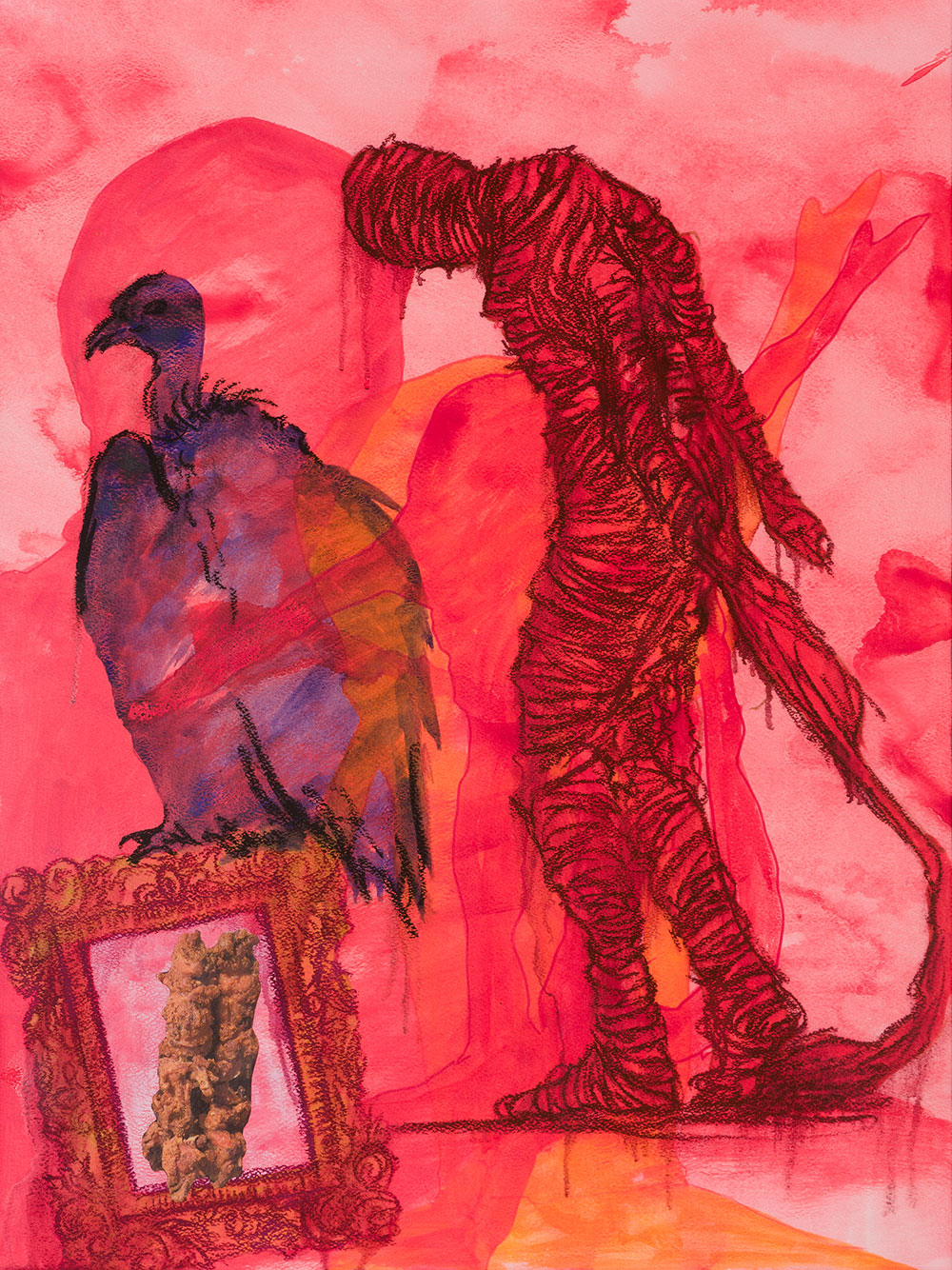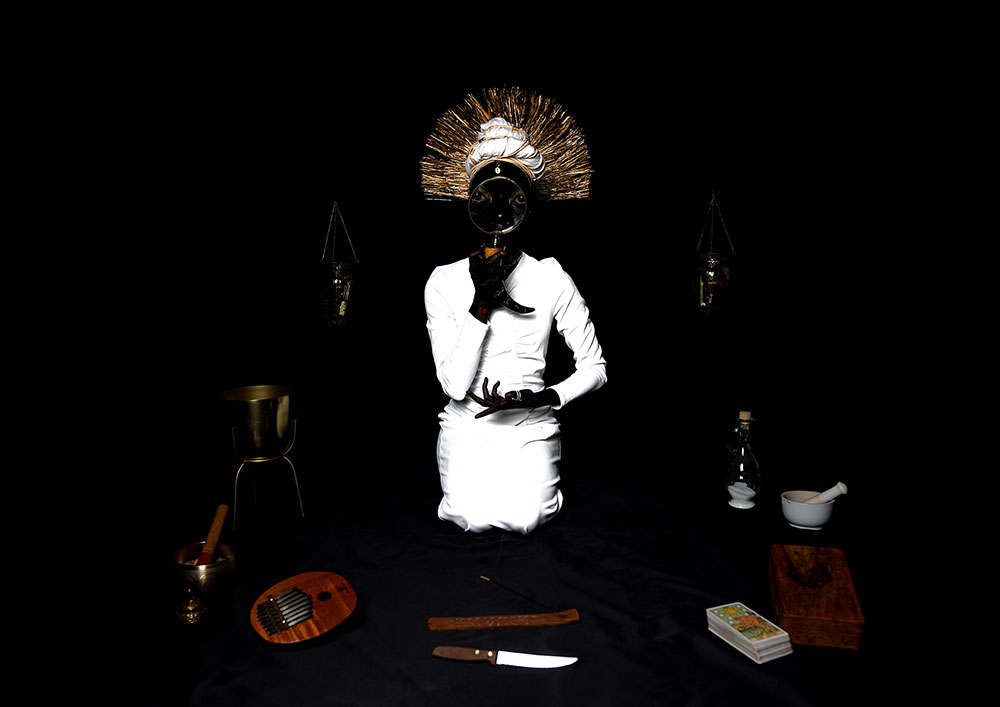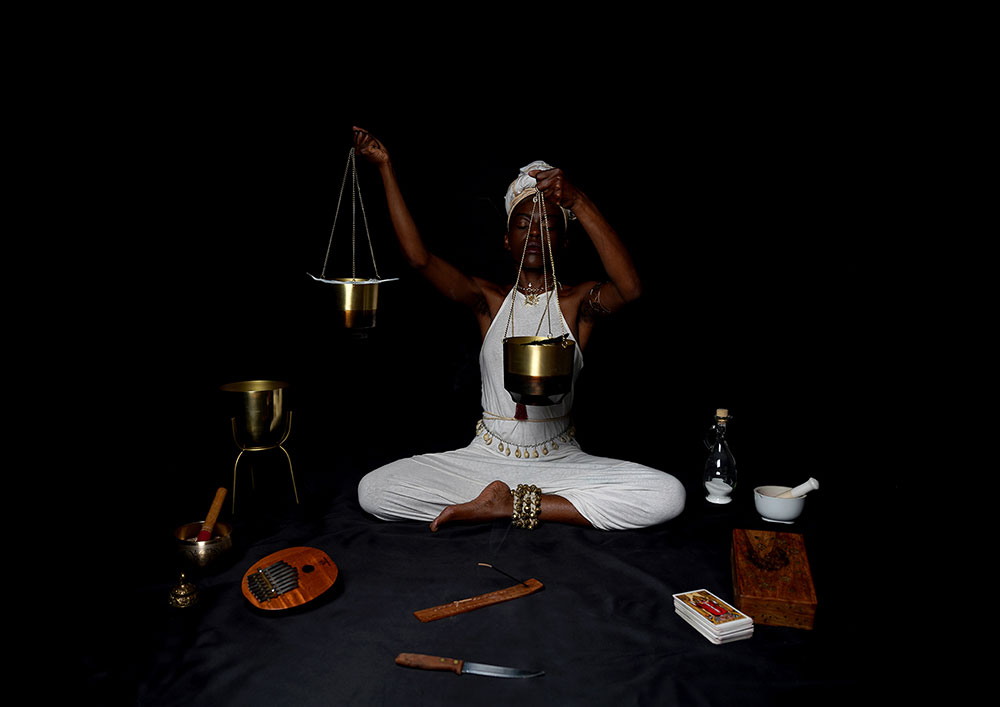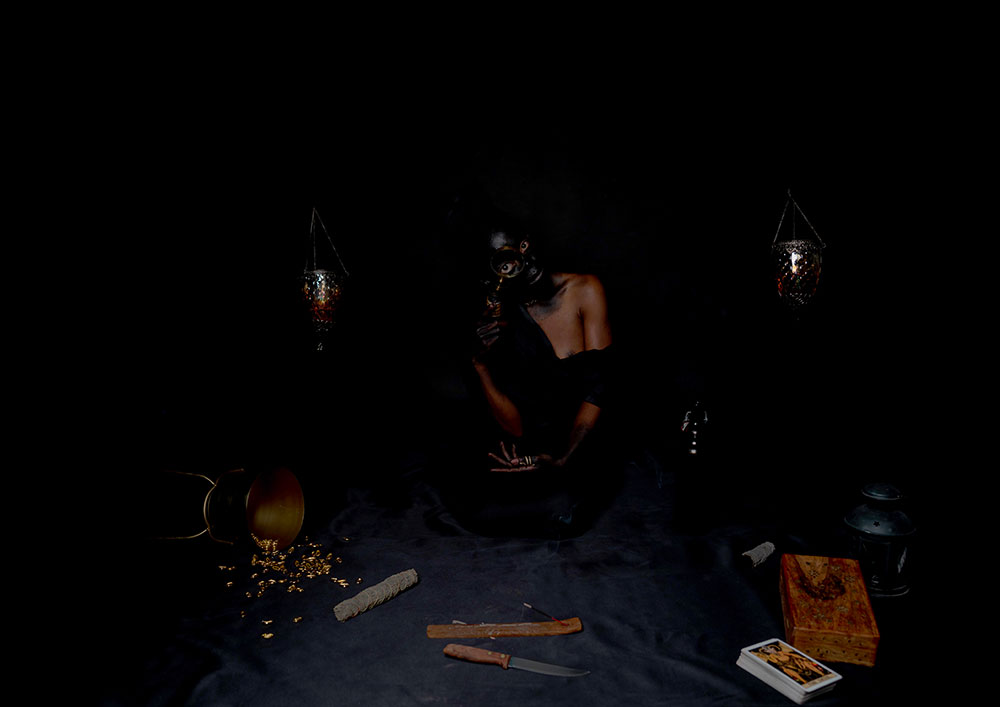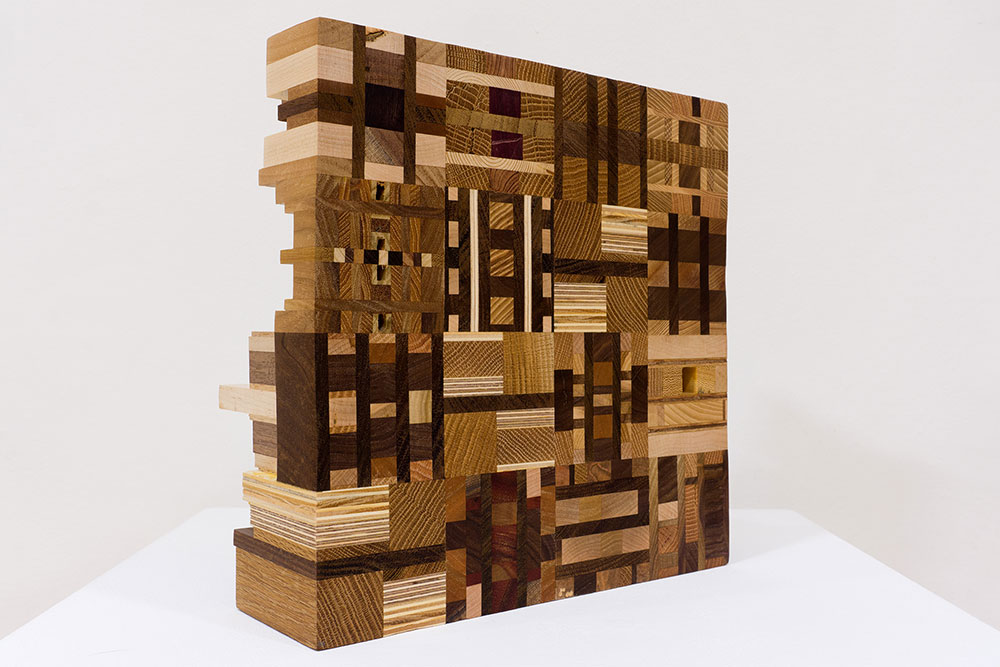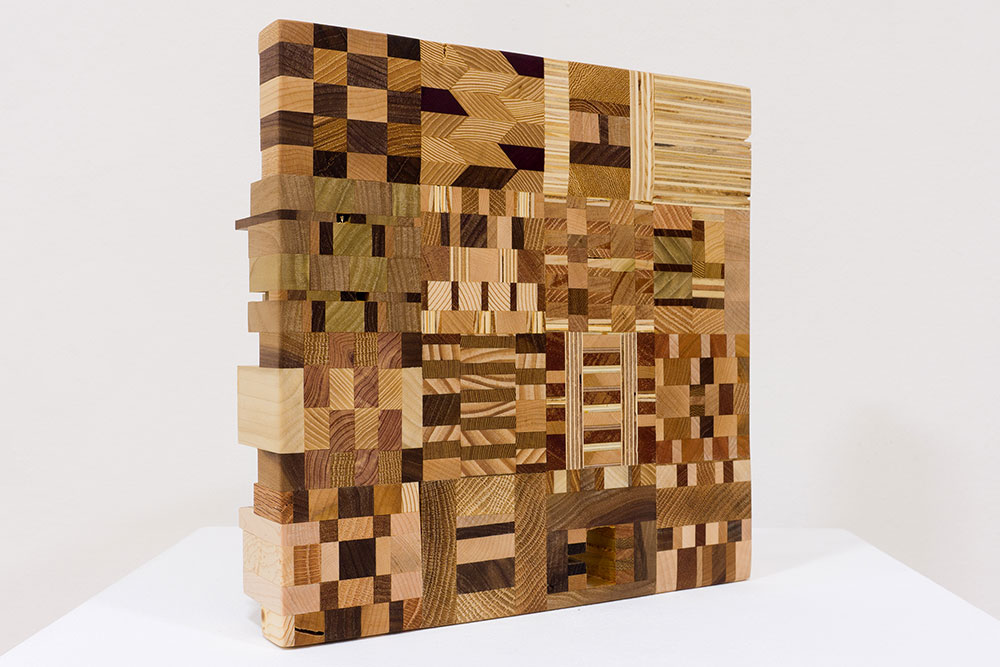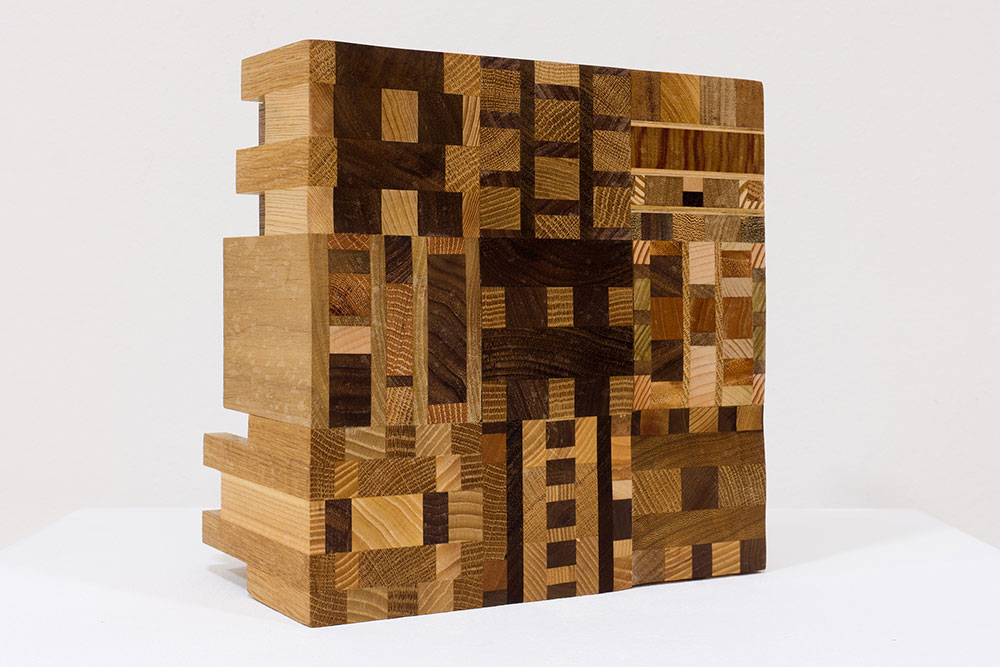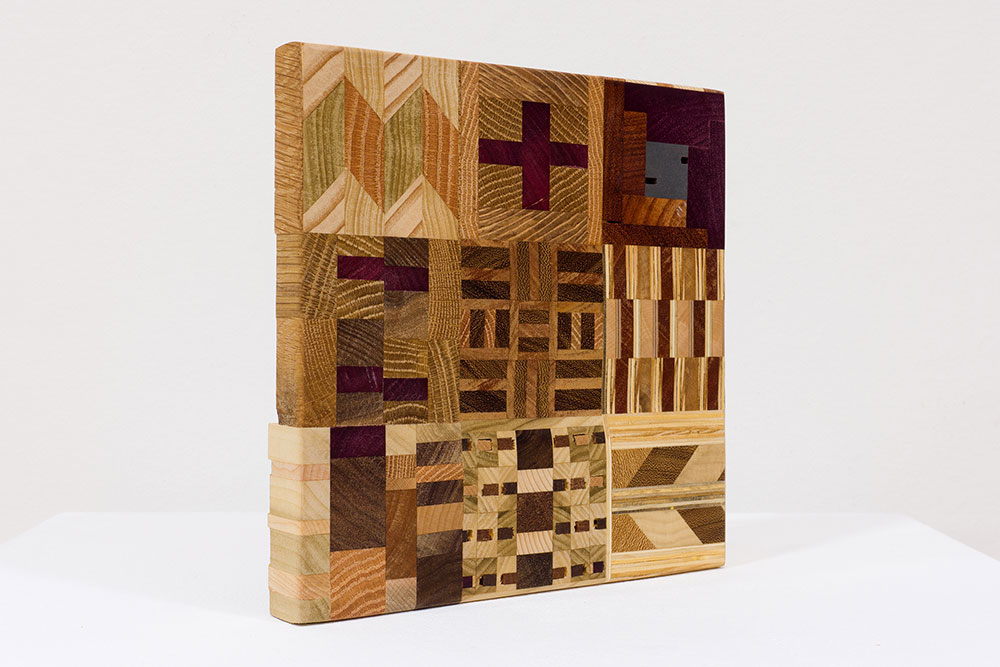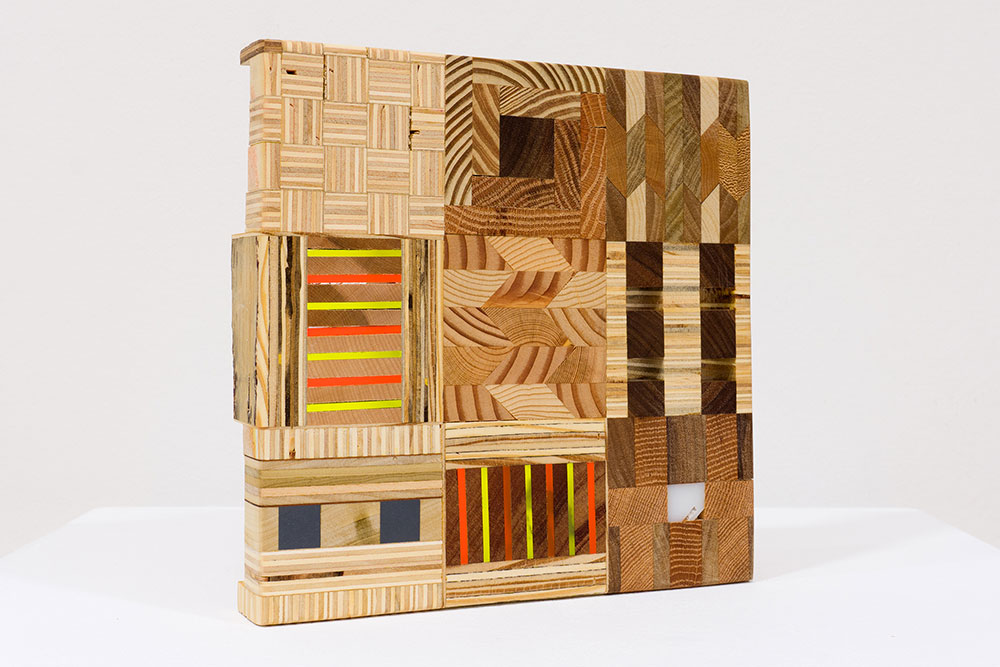The group exhibition "mundane x sacred x profane" brings together work by Valerie Amani, Philip Crawford, Samuel Baah Kortey, Sekai Machache, and Ato Ribeiro. The exhibition explores the blurring, conjoining and links between the everyday, the sanctified and the worldly or unholy. Working across different materials and medium, including collage on paper, photographic print, digital collage, painting, interactive performance, sound and wood sculpture, each artist unsettles fixed value judgments and signals towards the meeting points or melding of the mundane, the sacred, and the profane.
Within their respective practice there is a myriad of ways to encounter the unraveling and reeling in of meanings around what is mundane, what is sacred and what is profane. Through repetition and ritual, whether illustrated overtly or covertly, in reflections on the body, the spirit, and/or the soul in crisis painted, sculptured, digitally manipulated, captured in audio, stitched together by hand and in carefully ordered compositions, a remixing of narratives counternarratives, antinarratives come in and out of focus through referencing and repositioning very specific (albeit not always obvious) "every day" objects, symbols, language, instructions and gestures.
Three multi-media works by Valerie Amani open the space, with two paper abstract collage works made with ink, thread and watercolour paper titled, "Medina", "Alice" alongside "A Lesson on Choice", a textile piece made with muslin, acrylic, photo transfer and thread on fabriano paper. The textile piece is accompanied by a written-out handout with step-by-step instructions on how to select the ideal stone. The three works map out Amani’s re-telling of the Maji Maji rebellion and its reaffirmed legacies.
In the early 1900’s, in what is currently the Matumbi Highlands of Tanzania, a prophet claimed that he was immersed in water for 24 hours where he encountered a snake spirit - Hongo. The prophet, Kinjikitile Ngwale, is alleged to have emerged from the water completely dry, with a special medicine that could turn bullets into water called Maji Dawa (water medicine). News of this Maji Dawa spread across tribes in northern Tanzania, both uniting divided native groups as well as stirring resistance in the peoples under oppressive German colonial rule. What followed was a rebellion that lasted between 1905-1907; which although resulted in hundreds of thousands of African deaths, placed Kinjikitile and the Maji Maji rebellion as one of the cornerstones of pro-nationalism in East Africa.
Several decades later, Alice become an ideal figure to represent the intersection between magic, religion, violence and the metaphysical. Born nearly 50 years after the Maji Maji rebellion - she too, like Kinjikitile, was a woman touched by the world of the spirits. Her story is one of contradiction and violence - but also extreme vulnerability and desperation, when we consider the environments in which belief systems are birthed. Centering Alice, who was the founder of the Holy Spirit Movement, Amani’s collage works reflect on embodying the unseen (spirit) and mapping Alice’s journey from the 40 days she disappeared into a nature reserve to the rituals of war she developed. The three most prominent being the borrowed belief that blessed water would turn bullets into liquid; stones and rocks would transform into grenades and shouting James Bond three times would give one more strength. Drawn to the intertwined humour and tragedy that are prevalent in this story, Amani’s considers Alice's role as both prophet and Military leader.
In a similar vein, outlining the makings of belief and "make believe", Philip Crawford’s "How to Stay in the Pocket", a series 28 of digital collage prints based on evidence photos of a red diary which belonged to Malcolm X and a small date reminder card obscures the line between fact and fiction. The bullet-riddled diary and the reminder card(s) form the core of the collages. As viewers work their way through the series, they also move from documentary evidence (the red diary) towards something more speculative (manipulated repositioning of the reminder cards). "How to Stay in the Pocket" suggests a timeline beginning with the mundane fact of an originating violence (a Big Bang/the assassination of Malcolm X) lingering in a world where, even when visual information is incomplete or possibly fabricated, tomorrow always is. Crawford’s repeating sequence follows the diary with 27 configurations of the red perforated paper slips with the words "Tomorrow is" written across their center in black text. There is a way in which the repetition of the phrase "Tomorrow is" reinforces the coming-ness or indeed the anticipation of a tomorrow and in this recurring phrase time keeping becomes a kind of persistence towards a future (real or imagined).
"How to Stay in the Pocket" was completed in 2022 and is part of a body of work that broadly considers notions of selfhood and practices of self-defense in communities excluded from Enlightenment definitions of self. At its core, this body of work leverages popular references to self-defense in black diasporic communities (as kinesthetic knowledge, as political imperative, as religious right) to consider natal moments of black self-making and celebrate the improvisational nature of black practices of self-defensive care. This notion of self-defensive care reverberates the belief in bullets that turn to water and can therefore cause no bodily harm and needn’t be feared and stones that, with the correct instructions and rituals could turn into grenades to use against one’s opponent.
In the age of reasoning, questioning and critical thinking, Samuel Baah Kortey’s In Rembrance of the Mighty Healer, 00BC - Forever triptych explores spiritualism and beliefs by borrowing narratives, happenings and rituals from diverse sacred and mundane backgrounds. In pushing fantasies; the drawings capture Butoh dance practices by imagining the silence and stillness of Christ in between his crucifixion and resurrection. It looks at life, death and the symbiotic relationship between humans and objects. Each panel of the triptych is made of water color, pastels and photographs on paper, with a vulture set to the left side of each panel and the bird of prey perched on a framed photocollage of butchered meat, symbolism Kortey has used before as he incorporates the violent place of the abattoir in his research and work and uses blood from slaughtered animals on large scale installations of life-sized figures modeled after Christ on the cross, in one iteration hanging them upside down. In Rembrance of the Mighty Healer, 00BC - Forever, is paired back, smaller scale and rather than real blood the artist uses red of watercolour paint. The colour symbolism of "red of blood" still carries and fits the symbolism of the "red of wine" standing in for the blood of Christ in Christian iconography. Set to the right side of each panel is a drawn mummy, animated undead each portraying different postures of Butoh dance with translucent silhouettes of the figure(s), as though marking different stages of the dance.
In the research behind this work, Kortey takes as an entry point a curious gap that exists in Christian iconography – there are no available depictions of Christ in the three days between his death on the crucifix and his rising up. Kortey acknowledges that the most significant events in the story of Christ have in one way or another been portrayed over and over again where Christian religious documentation meets art history, where masters were commissioned or took on self-assigned undertakings to portray the life or Christ. And yet in this amassing of documentation the three days between death and resurrection remain a mystery. From these mummified figures, a wrap preserved dead body depicted in suspended motion (doing the Butoh dance), the artist carves out the outlines of a space of the simultaneously living and unliving. Alongside the triptych is a 2min 40 second sound piece titled, "Nkwa Nsuo Ne Paanoo" of a choir singing a hymn.
From the ordinary turned to the extraordinary, the natural to the supernatural, Ato Ribeiro employs familiar practices— of collecting, joining and refining natural and repurposed materials into wooden kente quilt works, mixed-media installations and prints that provide educational opportunities to seek out new points of reference, while preserving layers of African cultural heritage and varying ethnic perspectives. The five wooden sculptures in the exhibition are made of repurposed wood, acrylic, HDPE, and wood glue and are small scale relatives of "Sisala The Micro and Macro." The body of work (made from repurposed materials) with their geometric colour blocking in varying shades of brown bears witness to numerous examples of gerrymandering and gentrification around communities that are ignored by wielders of disproportionate power. And though the materials that make up these works were (and still are) the structural foundation and infrastructure for the 'United' States, the forgotten hard and soft woods hidden behind white gallery walls, they remain optimistic for the future because they know from whence they came. They are the results of a process aiming to preserve invaluable communities and explore alternate methods of making home.
In rearranging material assemblages of histories, "Sisala The Micro and Macro" along with other works by Ribeiro pay homage to interactions with griots from industrial workspaces around Detroit, to the Red Willow People of the Taos Pueblo and more. Through the process of assembling these repurposed and refined materials, Ribeiro finds ways to embed little known or perhaps forgotten knowledge systems into what could become everyday or everyday-like objects – objects that may have the capacity to co-exist in plain sight with the ignorant, the doubters and non-believers but are just as well made visible to nourish those who already know and those who seek to know.
Through ritual and the repetition therein, make believe turns to belief and what we believe to be true (fact or not) can lead to real tangible consequences. During a month’s long field research traveling through parts of India bearing witness to communal ceremonies resembling ceremonies of masquerade in Brazil and parts of West Africa, Sekai Machache conceived of the three-part photographic works made specifically for the exhibition and aptly titled "Sacred", "Mundane", and "Profane." Moving from and through belief (in) systems, myths turned to mythologies, factual visual objects to fictitious representations, resurrection of historical figures and knowledge systems there appear invitations to recover our faith in ourselves.
In each work Machache positions herself as the protagonist in a composition accompanied by several objects - for example. golden nuggets, gold chalices, and incense holder, bundle of sage, a thurible, a deck of tarot cards, a knife a sound bowl, a mixing bowl, and mbira – items that in varying contexts could symbolize highly sanctified objects, earthly things, or the secular and ungodly. Notably, in "Mundane" her eyes are closed and there is a direct gaze back to the viewer in "Sacred" and "Profane" (which is in fact enlarged with a magnifying glass held to the front of the face, over both eyes in "Sacred" and only over the right eye in "Profane." While the body is covered in both "Sacred" and "Mundane" (with bare shoulders) and the head in the first is adorned with a golden halo crown and with a white headwrap in the latter whereas, in "Profane" the covering droops revealing a bare shoulder and part of a bare breast and the top of the head is submerged in darkness so it is not revealed whether the head is either covered or adorned.
In the first two we also see the same objects appear, including the mbira and the mixing bowl, items which are missing in "Profane." And in Profane we see bundles of sage and a fallen over golden bowl revealing golden nuggets scattered on the floor to the side of the seated figure. This incomplete repetition of objects surrounding the seated figure creates a changeable framework for sense making so that in the viewer’s reading of the objects they too participate in the activation and parsing out of meaning through colour and material symbolism and through signaling through the viewed and viewing body.
It is in this amassing cosmology of fact vs. fiction, alive vs. dead, sacred vs. unholy, that perhaps each of us can occupy third or alternative spaces and we become vessels of/for story-forming, story-holding, story-telling – we become not only sense makers but world makers by our beliefs or through our faith, and we develop the capacity to activate and make malleable the sacred, the mundane and the profane. The artists’ activate through their re-telling, reformulating, juxtaposing and enchanting carpentry, transform objects, the living and the dead, and (re)activate knowledge systems past, present and together they embed these in a multiplicity of futures.
